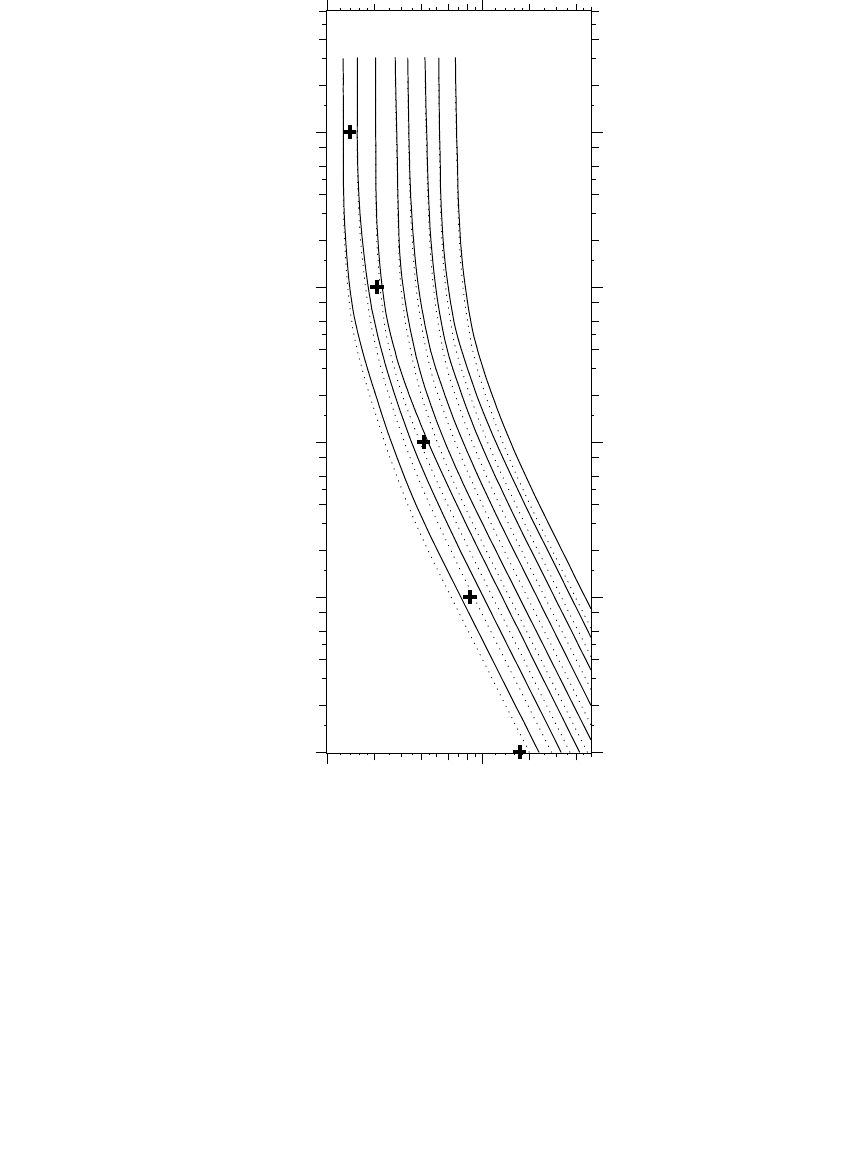Short T.A. Electric Power Distribution Handbook
Подождите немного. Документ загружается.


Short-Circuit Protection 397
Cutouts are rated on a symmetrical basis. Cutouts are tested at X/R ratios
of 8 to 12, so if the X/R ratio at the application point is higher than the test
value, the cutout should be derated. The fuse line holder determines the
interrupting capability, not the fuse link.
Most cutouts are of the open variety with a removable fuse holder that is
placed in a cutout with a porcelain-bushing type support. We also find
enclosed cutouts and open-link cutouts. Open links have a fuse link sus-
pended between contacts. Open links have a much lower interrupting capa-
bility (1.2 kA symmetrical).
Many cutouts available are full-rated cutouts that can be used on any type
of system where the maximum line-to-line voltage is less than the cutout
rating. Cutouts are also available that have slant voltage ratings, which
provide two ratings such as 7.8/15 kV that are meant for application on
grounded circuits (IEEE Std. C37.48-1997). One cutout will interrupt any
current up to its interrupting rating and up to the lower voltage rating. On
a grounded distribution system, in most situations, any cutout can be applied
that has the lower slant rating voltage greater than the maximum line-to-
ground voltage. On a 12.47Y/7.2-kV grounded distribution system, a 7.8/
15-kV cutout could be used. If the system were ungrounded, a full-rated 15-
kV cutout must be used. For three-phase grounded circuits, the recovery
voltage is the line-to-line voltage for a line-to-line fault rather than the line-
to-ground voltage (requiring a higher voltage rating). In this case, the slant
rated cutouts are designed and tested so that two cutouts in series will
interrupt a current up to its interrupting rating and up to the higher voltage
rating. The two cutouts share the recovery voltage (even considering the
differences in the melting times of the two fuses). On grounded systems,
there are cases where slant-rated cutouts are “under-rated” — any time that
a phase-to-phase fault could happen that would only be cleared by one
TABLE 8.4
Fuse Minimum-Melt I
2
t (A
2
-s)
Rating, A K Links T Links
6 534 1,490
8 1,030 2,770
10 1,790 5,190
12 3,000 8,810
15 5,020 15,100
20 8,500 24,500
25 13,800 40,200
30 21,200 65,500
40 36,200 107,000
50 58,700 173,000
65 90,000 271,000
80 155,000 425,000
100 243,000 699,000
140 614,000 1,570,000
200 1,490,000 3,960,000
1791_book.fm Page 397 Monday, August 4, 2003 3:20 PM
(C) 2004 by CRC Press LLC

398 Electric Power Distribution Handbook
cutout. This includes constructions where multiple circuits share a pole or
cases where cutouts are applied on different poles.
Most cutouts used on distribution systems do not have load break capa-
bility. If the cutout is opened under load, it can draw an arc that will not
clear. It is not an uncommon practice for crews to open cutouts under load
(if it draws an arc, they slam it back in). Cutouts with load-break capability
are available, usually capable of interrupting 100 to 300 A. Cutouts with
load-break capability usually use an arc chute. A spring pulls the arc quickly
through the arc chute where the arc is stretched, cooled, and interrupted. A
load-break tool is available that can open standard cutouts (with no load
break capability of its own) under load up to 600 to 900 A. Utilities also
sometimes use solid blades in cutouts instead of a fuse holders; then crews
can use the cutout as a switch.
8.2.6 Current-Limiting Fuses
Current limiting fuses (CLFs) are another interrupter having the unique
ability to reduce the magnitude of the fault current. CLFs consist of fusible
elements in silicon sand (see Figure 8.10). When fault current melts the
fusible elements, the sand melts and creates a narrow tube of glass called a
fulgerite. The voltage across the arc in the fulgerite greatly increases. The
fulgerite constricts the arc. The sand helps cool the arc (which means it takes
energy from the arc). The sand does not give off ionizable gas when it melts,
and it absorbs electrons, so the arc has very little ionizable air to use as a
conductor. Without ionizable air, the arc is choked off, and the arc resistance
becomes very high. This causes a back voltage that quickly reduces the
current. The increase in resistance also lowers the X/R ratio of the circuit,
causing a premature current zero. At the current zero, the arc extinguishes.
Since the X/R ratio is low, the voltage zero and current zero occur very close
together, so there will be very little transient recovery voltage (the high arc
voltage comes just after the element melts). Because the current-limiting fuse
FIGURE 8.10
Example backup current-limiting fuse. (From Hi-Tech Fuses, Inc. With permission.)
1791_book.fm Page 398 Monday, August 4, 2003 3:20 PM
(C) 2004 by CRC Press LLC

Short-Circuit Protection 399
forces an early current zero, the fuse can clear the short circuit in much less
than one half of a cycle.
Current-limiting fuses are noted for their very high fault-clearing capabil-
ity. CLFs have symmetrical maximum interrupt ratings to 50 kA; contrast
that to expulsion fuses which may have typical maximum interrupt ratings
of 3.5 kA in oil and 13 kA in a cutout. Current-limiting fuses also completely
contain the arc during operation and are noiseless with no pressure buildup.
Current-limiting fuses are widely used for protection of equipment in high
fault current areas. Table 8.5 shows the percentages of utilities that use CLFs.
The major reason given for the use of CLFs is safety, and the second most
common reason is high fault currents in excess of expulsion fuse ratings.
There are three types of current-limiting fuses (IEEE Std. C37.40-1993):
• Backup: A fuse capable of interrupting all currents from the maxi-
mum rated interrupting current down to the rated minimum inter-
rupting current.
• General Purpose: A fuse capable of interrupting all currents from the
maximum rated interrupting current down to the current that causes
melting of the fusible element in one hour.
• Full Range: A fuse capable of interrupting all currents from the rated
interrupting current down to the minimum continuous current that
causes melting of the fusible element(s), with the fuse applied at the
maximum ambient temperature specified by the manufacturer.
Current-limiting fuses are very good at clearing high-current faults. They
have a much harder time with low-current faults or overloads. For a low-
level fault, the fusible element will not melt, but it will get very hot and can
melt the fuse hardware resulting in failure. This is why the most common
CLF application is as a backup in series with an expulsion fuse. The expulsion
fuse clears low-level faults, and the CLF clears high-current faults. Current-
limiting fuses have very steep melting and clearing curves, much steeper
than expulsion links. Many current-limiting fuses have steeper characteris-
TABLE 8.5
Use of Current-Limiting Fuses as Reported in a 1995
IEEE Survey
5 kV 15 kV 25 kV 35 kV
General Purpose 15% 29% 30% 18%
Backup 15% 38% 43% 30%
On OH Line Laterals 5% 6% 9% 3%
On UG Line Laterals 7% 18% 20% 18%
Source: IEEE Working Group on Distribution Protection,
“Distribution Line Protection Practices — Industry Survey
Results,” IEEE Transactions on Power Delivery, vol. 10, no. 1,
pp. 176–86, January 1995.
1791_book.fm Page 399 Monday, August 4, 2003 3:20 PM
(C) 2004 by CRC Press LLC

400 Electric Power Distribution Handbook
tics than I
2
t. At low currents, heat from the notches transfers to the un-
notched portion; at high currents, the element melts faster because heat
cannot escape from the notched areas fast enough to delay melting.
General-purpose fuses usually use two elements in series — one for the
high-current faults and one for the low-current faults. General-purpose fuses
could fail for overloads, so restrict their application to situations where
overloads are not present or are protected by some other device (such as a
secondary circuit breaker on a transformer).
Full-range fuses provide even better low-current capability and can handle
overloads and low-level faults without failing (as long as the temperature
is within rating).
Current-limiting fuses can be applied in several ways including:
• Backup current-limiting fuse in series with an expulsion fuse in a
cutout
• Full-range current-limiting fuse in a cutout
• Backup CLF under oil
• Full-range (or general-purpose) fuse under oil
• CLF in a dry-well canister or insulator
The best locations for use on distribution systems are close to the substa-
tion. This is where they are most appropriate for limiting damage due to
high fault currents and where they are most useful for reducing the magni-
tude and duration of a voltage sag.
Some of the drawbacks of current-limiting fuses are summarized as
• Voltage kick — When a CLF operates, the rapidly changing current
causes a voltage spike (V = Ldi/dt). Usually, this is not severe enough
to cause problems for the fuse or for customer equipment.
• Limited overload capability — A backup or general-purpose fuse does
not do well for overloads or low-current faults. A full-range fuse
performs better but could still have problems with a transient over-
current that partially melts the fuse.
• Coordination issues — A current-limiting fuse may be difficult to
coordinate with expulsion fuses or reclosers or other distribution
protective devices. CLFs are fast enough that they almost have to be
used in a fuse-blowing scheme (fuse saving will not work because
the fuse will be faster than the circuit breaker).
• Cost — High cost relative to an expulsion fuse.
Current-limiting fuses limit the energy at the location of the fault. This
provides safety to workers and the public. Arc damage to life and property
occurs in several ways:
1791_book.fm Page 400 Monday, August 4, 2003 3:20 PM
(C) 2004 by CRC Press LLC

Short-Circuit Protection 401
• Pressure wave — The fault arc pressure wave damages equipment
and personnel.
• Heat — The fault arc heat burns personnel and can start fires.
• Pressure buildup in equipment — An arc in oil causes pressure buildup
that can rupture equipment.
All of these effects are related to the arc energy and all are greatly reduced
with current-limiting fuses. Distribution transformers are a common appli-
cation of current-limiting fuses to prevent them from failing violently due
to internal failures.
8.3 Transformer Fusing
The primary purpose of a transformer fuse is to disconnect the transformer
from the circuit if it fails. Some argue that the fuse should also protect for
secondary faults. The fuse cannot effectively protect the transformer against
overloads.
Engineers most commonly pick fuse sizes for distribution transformers
from a fusing table developed by the utility, transformer manufacturer, or
fuse manufacturer. These tables are developed based on criteria for applying
a fuse such that the fuse should not have false operations from inrush and
cold-load pickup.
One way to pick a fuse is to plot cold-load pickup and inrush points on
a time-current coordination graph and pick a fuse with a minimum melt or
damage curve that is above the cold-load and inrush points. Most fusing
tables are developed this way. A fuse should withstand the cold-load and
inrush points given in Table 8.6. The inrush points are almost universal, but
the cold-load pickup points are more variable (and they should be since
cold-load pickup characteristics change with predominant load types). An
example application of the points given in Table 8.6 for a 50-kVA, 7.2-kV
single-phase transformer which has a full-load current of 6.94 A is shown
in Figure 8.11. The cold-load pickup and inrush points are plotted along
with K links. The minimum melt time and the damage time (75% of the
minimum melt time) are shown. Use the damage curve to coordinate. For
this example, a 12-A K link would be selected; the 1-sec cold-load pickup
point determines the fuse size. Since this point lies between the damage and
minimum melt time of the 10K link, some engineers would pick the 10K
link (not recommended).
Some utilities have major problems from nuisance fuse operations (espe-
cially utilities in high-lightning areas). A nuisance operation means that the
fuse must be replaced, but the transformer was not permanently damaged.
Nuisance fuse operations can be over 1% annually. Some utilities have thou-
1791_book.fm Page 401 Monday, August 4, 2003 3:20 PM
(C) 2004 by CRC Press LLC

402 Electric Power Distribution Handbook
sands of nuisance fuse operations per year. A utility in Florida had a region
with 57% of total service interruptions due to transformer interruptions, and
63% of the storm-related interruptions required only re-fusing (Plummer et
al., 1995). During a storm, multiple transformer fuses can operate on the
same circuit. There are differences of opinion as to what is causing the
nuisance operations. Some of the possibilities are
• Inrush — Transformer inrush may cause fuse operations even though
the inrush points are used in the fuse selection criteria. Reclosing
sequences during storms can cause multiple inrush events that can
heat up the fuse. In addition, voltage sags can cause inrush (any
sudden change in the voltage magnitude or phase angle can cause
the transformer to draw inrush).
• Cold-load pickup — This is the obvious culprit after an extended
interruption (many of the nuisance fuse operations have occurred
when there is not an extended interruption).
• Secondary-side transformer faults — Secondary-side faults that self-
clear can cause some nuisance fuse events.
• Lightning current — Lightning current itself can melt small fuses.
Arrester placement is key here since the lightning current flows to
the low-impedance provided by a conducting arrester. If the fuse is
upstream of the arrester (which would be the case on a tank-
mounted arrester), the lightning surge current flows through the
fuse link. If the fuse is downstream, then little current should flow
through the fuse.
TABLE 8.6
Inrush and Cold-Load Pickup Withstand Points
for Transformer Fusing
Full-Load Current
Multiplier
Duration,
sec
Cold-load pickup 2 100
310
61
Inrush points 12 0.1
25 0.01
Source: Amundson, R. H., “High Voltage Fuse Protec-
tion Theory & Considerations,” IEEE Tutorial Course
on Application and Coordination of Reclosers, Section-
alizers, and Fuses, 1980. Publication 80 EHO157–8-
PWR; Cook, C. J. and Niemira, J. K., “Overcurrent Pro-
tection of Transformers—Traditional and New Philos-
ophies for Small and Large Transformers,” IEEE/PES
Transmission & Distribution Conference and Exposi-
tion, 1996. Presented at the training session on “Distri-
bution Overcurrent Protection Philosophies.”
1791_book.fm Page 402 Monday, August 4, 2003 3:20 PM
(C) 2004 by CRC Press LLC

Short-Circuit Protection 403
• Power-follow current through gapped arresters — Following operation
of a gapped arrester, a few hundred amps of power follow current
flows in a gapped silicon carbide arrester until the gap clears (usually
just for a half cycle if the gap is in good shape).
• Transformer saturation from lightning currents — Lightning can contain
multiple strokes and long-duration components that last from 0.1 to
FIGURE 8.11
Transformer inrush and cold-load pickup points for a single-phase, 50-kVA, 7.2-kV transformer.
The minimum-melt curves and damage curves (dotted lines) for K-link fuses are also shown.
6
8
10
12
15
20
25
30
10.0 100.0
0.01
0.1
1.0
10.0
100.0
Current, amps
Time, seconds
1791_book.fm Page 403 Monday, August 4, 2003 3:20 PM
(C) 2004 by CRC Press LLC

404 Electric Power Distribution Handbook
2 sec. These currents can saturate distribution transformers. Follow-
ing saturation, the transformer becomes a low impedance and draws
high current from the system through the fuse (Hamel et al., 1990).
• Animal faults — Across transformer bushings or arresters.
Several of these causes may add to the total. Nuisance fuse operations
have occurred when circuits were out of service. This means that lightning
is the cause since any type of inrush would require the system to be ener-
gized. Detroit Edison found that 70 to 80% of fuse operations were due to
lightning (Gabrois et al., 1973). Lightning and inrush events are the most
likely cause of nuisance fuse operations. Heavily loaded transformers are
more susceptible to nuisance fuse operations because of the preheating of
the fuse (a heavily loaded transformer is more susceptible to cold-load
pickup as well).
Another method of choosing the transformer fuse size that gives “looser”
fusing is the ¥2 method (Burke, 1996). Choose a fuse size larger than twice
the transformer full load current. A 50-kVA, 7.2-kV single-phase transformer,
which has a full-load current of 6.94 A, should have a fuse bigger than 14 A
(the next biggest standard size is a 15-A fuse). This applies for any type of
fuse (K, T, or other). The factor of two provides a safety margin so that
transformer fuses do not operate for inrush or cold-load pickup, and it helps
with lightning.
The fusing ratio is the ratio of the fuse minimum melt current to the
transformer full-load current (some sources also define a fusing ratio as the
ratio of fuse rated current to transformer rated current which is different
from this definition by a factor of two). Tight fusing means the fuse ratio is
low. Relatively low fusing ratios have been historically used which has led
to the nuisance fuse problems. The tighter fusing given using the Table 8.6
approach results in fusing ratios of 2 to 4. The looser ¥2 method gives a
fusing ratio of at least 4 (since the fuse rating is multiplied by two, and the
minimum melting current at 300 sec is twice the fuse rating). The fusing
ratio for the 50-kVA, 7.2-kV transformer with the 12-K fuse is 3.46, and it is
4.32 with the 15-K fuse.
Another strategy that is especially useful in high lightning areas: use a
standard fuse size for all transformers up to a certain size. This also helps
ensure that the wrong fuse is not applied on a given transformer. A standard
fuse size of at least 15T or 20K results in few nuisance fuse operations (IEEE
Std. C62.22-1997). At 12.5 kV, a 20K fuse should protect a 5-kVA transformer
almost as well as it protects a 50-kVA transformer. It may lose some second-
ary protection relative to a smaller fuse, and a small portion of evolving
faults will not be detected as soon; but other than that, there should not be
much difference. If fuses get too big, they may start to bump up against tap
fuse sizes and limit fuse options for lateral taps.
If looser fusing is used, some argue that overload protection of transform-
ers is lost. Countering that argument, overload protection with fuses is not
1791_book.fm Page 404 Monday, August 4, 2003 3:20 PM
(C) 2004 by CRC Press LLC

Short-Circuit Protection 405
really possible if the transformer is used for its most economic performance
(which means overloading a transformer at peak periods). To avoid nuisance
fuse operations from load, we must use a fuse big enough so that thermal
overload protection is impossible. It is also argued that most transformer
failures start as failures between turns or layers and that a smaller, faster
fuse detects this more quickly. Tests have indicated that a smaller fuse might
not be much better than a larger fuse at detecting interwinding failures
(Lunsford and Tobin, 1997) (pressure-relief valves limit tank pressures very
well during this type of failure). All together, the arguments for a smaller
fuse are not enough to overcome the concerns with nuisance fuse operations.
If overload protection must be used, use a surge resistant fuse (it has a slower
characteristic for high-magnitude, short-duration currents).
A few utilities practice group fusing where a lateral fuse provides protec-
tion to all of the transformers on the tap. If the transformer failure rate
(including bushing faults) is low enough, then this practice will not degrade
the overall frequency of interruptions significantly. One of the major disad-
vantages of this approach is that an internal transformer failure on a tap
may be very hard to find. This drives up repair time (so the duration reli-
ability numbers suffer but not necessarily the frequency indices). Also, the
beneficial feature of being able to switch the transformer with the fused
cutout is lost if group fusing is used.
Widely used, completely self-protected transformers (CSPs) have an inter-
nal weak-link fuse; an external fuse is not needed (although they may need
an external current-limiting fuse to supplement the weak link).
Transformer bushing faults often caused by animals can have different
impacts depending on fusing practices. A fault across a primary bushing
operates an external transformer fuse. If the transformer is a CSP or group
fusing is used, the upstream tap fuse operates (so more customers are
affected).
Current-limiting fuses are regularly used on transformers in high fault-
current areas to provide protection against violent transformer failure.
NEMA established tests which were later adopted by ANSI (ANSI C57.12.20-
1988) for distribution transformers to be able to withstand internal arcs.
Transformers with external fuses are subjected to a test where an internal
arcing fault with an arc length of 1 in. (2.54 cm) is maintained for 1/2 to 1
cycle. It was thought that 1 in. (2.54 cm) was representative of the length
that arcs could typically achieve. The current is 8000 A. Under this fault
condition, the transformer must not rupture or expel excessive oil. Note that
this test does not include all of the possible failure modes and is no guarantee
that a transformer will not fail with lower current. For example, a failure
with an arc longer than 1 in. has more energy and ruptures the transformer
at a lower level of current.
Table 8.7 shows rupture limits for several types of transformers based on
tests for the Canadian Electrical Association. If fault current values exceed
those given in this table, consider using current-limiting fuses to reduce the
chance of violent failures (the CEA report considers the limits provisional
1791_book.fm Page 405 Monday, August 4, 2003 3:20 PM
(C) 2004 by CRC Press LLC

406 Electric Power Distribution Handbook
and suggests that more tests are needed). At arc energies within this range,
the failure probability is on the order of 15 to 35%. Note that the 2.5-kA limit
for pole-mounted transformers is much less than the ANSI test limit of 8 kA.
Based on a series of tests with internal 2-in. (5 cm) arcs, Hamel et al. (2003)
recommend considering current-limiting fuses for pole-type transformers
when the short-circuit current exceeds 1.7 kA.
For transformers with an internal fuse, completely self-protected (CSP)
transformers or padmounted transformers, the arcing test is done to the
rating of the fuse which is generally much lower than 8000 A. Table 8.8 shows
the maximum fault current ratings based on the ANSI tests. If the available
line-to-ground fault current exceeds these values, then consider current-
limiting fuses to reduce the possibility of violent failures. Not all utilities use
current-limiting fuses in these situations, and in such instances, internal
faults have failed transformers violently, blowing the cover.
If a transformer is applied in a location where the available line-to-ground
fault current is higher than shown in Table 8.8, use current-limiting fuses.
TABLE 8.7
Transformer Rupture Limits for Internal Faults
Transformer Type
I ◊◊
◊◊
t, A-s, or
Coulombs
Current Limit for a
1 Cycle Clearing
Time, kA
Pole mounted 1f 41 2.5
Pad mounted 1f 150 9
Pad mounted/subway 3f 180 11
Network with switch compartment 3f 90 5.4
Submersible and vault 1f 41 2.5
Source: CEA 288 D 747, Application Guide for Distribution Fusing, Canadian Elec-
trical Association, 1998.
TABLE 8.8
Maximum 1/2- to 1-Cycle Fault Current Rating on Distribution
Transformers Based on the Test in ANSI C57.12.20-1988
Transformer
Maximum Tested
Symmetrical Current
ÚIdt
in the ANSI Test
Overhead transformer 8000 A 66.7 A-s
Under-oil expulsion fuse
(based on typical fuse ratings)
Up to 8.3 kV
LG
3500 A 29.2 A-s
Up to 14.4 kV
LG
2500 A 20.8 A-s
Up to 25 kV
LG
1000 A 8.3 A-s
Source: ANSI C57.12.20-1988, American National Standard Requirements for Over-
head-Type Distribution Transformers, 500 kVA and Smaller: High-Voltage, 67 000
Volts and Below; Low-Voltage, 15 000 Volts and Below, American National Stan-
dards Institute.
1791_book.fm Page 406 Monday, August 4, 2003 3:20 PM
(C) 2004 by CRC Press LLC
